 advertisements advertisements
|

|
'Moon Gallery' prototype arrives at space station with 64 works of art
February 21, 2022 — Packed among the scientific research and crew supplies delivered by a cargo craft to the International Space Station early Monday morning (Feb. 21), was a small purple box "housing the seeds of a future, interplanetary culture."
Or so reads the inscription printed on the side of the canister.
Dubbed the "Moon Gallery" — the collection of miniature works of art, each no larger than 0.06 cubic inches (1 cubic centimeter), is a prototype test payload that will pave the way for delivering a similar gallery to the surface of the moon.
"We are beyond thrilled that the Moon Gallery, with the support of Nanoracks, is taking its first journey to the cosmos," Anna Sitnikova, the payload's curator and co-founder of the Moon Gallery Foundation, said in a statement. "We hope that this mission will teach us a lot about the conditions in space and will inspire artists for our next mission — the moon, as we seek to extend our cultural dialogue to the furthest reaches of human exploration."
The current Moon Gallery was launched on Northrop Grumman's NG-17 Cygnus spacecraft, also known as the S.S. Piers Sellers, from NASA's Wallops Flight Facility in Virginia on Saturday (Feb. 19). The uncrewed ship was captured by the space station's Canadarm2 robotic arm at 4:44 a.m. EST (0944 GMT) on Monday and then berthed to the complex's Unity node at 7:02 a.m. EST (1202 GMT).
Arranged in an eight by eight grid, the works of art vary in material and format, from 2D prints to 3D free-floating objects, as well as one AR (augmented-reality) engraving. Among the works included in the space station's gallery are:
Gabriele Lorusso's "The Two Moons" — Two totems separated from each other, the space station payload contains a blue marble symbolizing the planet Earth, while its companion, a grey marble made with lunar soil, remains on the ground.
"In this way, a lunar crew can remember the people who live on Earth and Earth itself whenever they look at the marble, staying anchored to their existence and to that of the whole planet. Back on Earth, terrestrials can look at the grey marble, and remember those up there," wrote Lorusso of his contribution.
The Gathering's "How to Measure a Planet?" — Contained on a microchip is this alternative rock band's album by the same title. The work also includes a small roll of magnetic tape with a fragment of the music and a small scroll of paper with a personal message, as well as the formula for "how to measure a planet."
"Although it cannot be played or listened to on the moon itself, due to a lack of oxygen over there, it can be carried out elsewhere," wrote the members of the Dutch music group.
Lorenzo Viscidi Bluer's "Water on the Moon" — Drops of water that are suspended in a Plexiglas cube.
"The immense and the minimum have a common root, the drops of water become stars," wrote Bluer.
Hady Milani's "ELEMENTO" — A 3D-printed structure made of a space-grade rhodium-platinum alloy, which is the same alloy used to make rocket nozzles and jet igniters.
"It has 120 equal facets in which will be placed samples of all the elements that can be found naturally on Earth. All packed with info in what resembles the Earth itself," Milani wrote.
Marcus Neustetter's "A Letter to SumbandilaSat" — A zig-zag folded paper with a drawing in ink, representing a cross-section of an imaginary terrain on one side and a hand written morse-code-message on the other.
SumbandilaSat is a South African micro Earth observation satellite, which ceased functioning in 2011. Being able to track it but not communicate with it or receive its images, Neustetter's "letter" is an attempt to make contact with the satellite and "lead the way again. Maybe not in the way she was intended to operate when launched in 2009, but in continuing to stimulate the imaginary, question the unknown and speculate new perspectives into space and onto Earth."
A full list of artists and artworks is available on the Moon Gallery website.
Though project officials hopes that the art will inspire discussions and bring joy to the crew, the payload also has a technical purpose for being aboard the station.
The Moon Gallery is housed in a "plug and play" research module provided by Nanoracks, a Texas-based space services company. The art works, which are free to float inside the module, will serve as moving targets for the company's camera performance tests.
The gallery provides a range of materials and behaviors for the camera to detect, and in return, the artists will get a chance to learn about the performance of their creations in the microgravity of space.
"The passion of those involved in the Moon Gallery project is infectious, and the culmination of their efforts shows that art and science in space do not have to be mutually exclusive," Scott Rodriguez, vice president of government programs at Nanoracks, said in statement.
"The lessons we learn from this endeavor about containment, material dynamics and enhanced imagery will help in the design of future experiments and in implementation of The Moon Gallery's ultimate goal to establish the first art gallery on the moon, he said."
The moon-bound version of the Moon Gallery is planned to launch 100 artworks on the exterior of a lunar lander headed to the moon as soon as 2025. In the interim, the ISS payload will stay in orbit for the next 10 months.
"Each piece in this tiny gallery with a big mission explores the meaning of a shared human culture," the inscription on the current Moon Gallery reads. "Away from the surface of our planet, its borders and rich differences, how do we define human culture? What ideas do we want to promote into the future? What ideas do we want to leave behind?" |
|
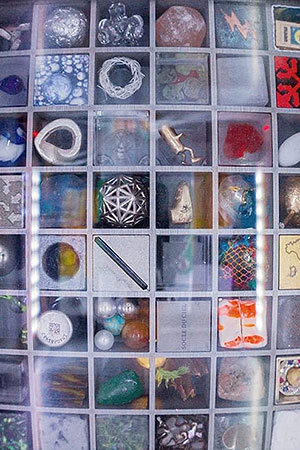
NanoRacks' Nanolab camera view of the 64 works of art comprising the Moon Gallery test payload now onboard the International Space Station for the next 10 months. (Moon Gallery Foundation)
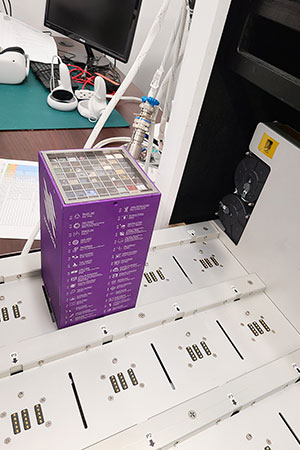
The Moon Gallery ISS payload, now aboard the International Space Station, being tested prior to launch. (Moon Gallery Foundation)
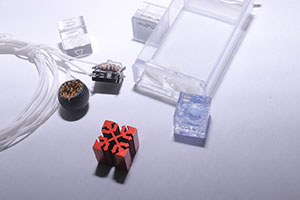
The Moon Gallery ISS payload is seen being assembled, including works by international artists Annamaria Zanella, Lakshmi Mohanbabu and Lorenzo Viscidi Bluer. (Moon Gallery Foundation)
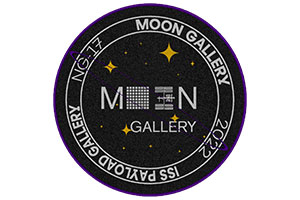
The Moon Gallery ISS mission patch. (Moon Gallery Foundation) |
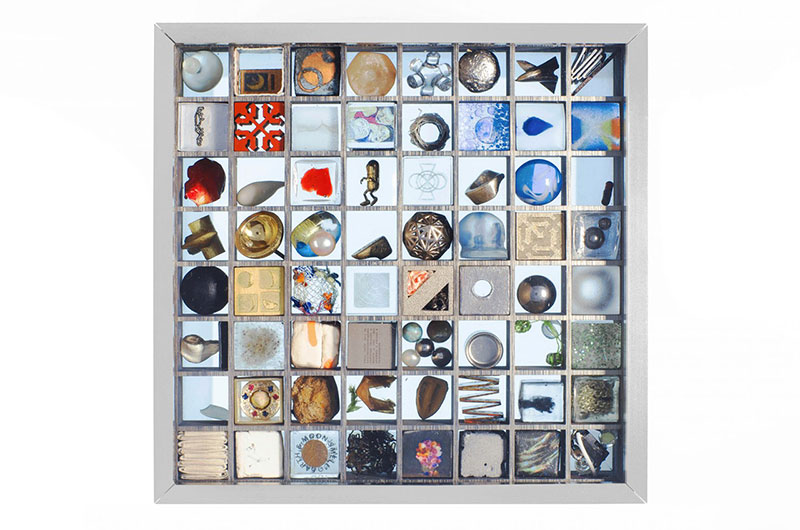
The artworks in the Moon Gallery ISS payload were created by artists from Asia, Europe, North America, South America and Africa. (Moon Gallery) |
|

© collectSPACE. All rights reserved.
|
|

|

|
